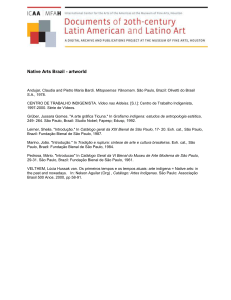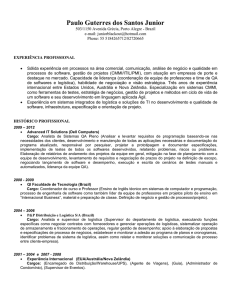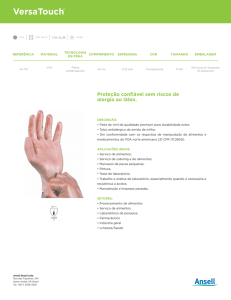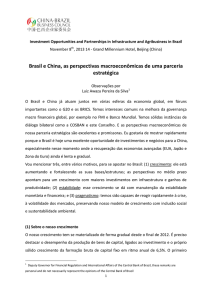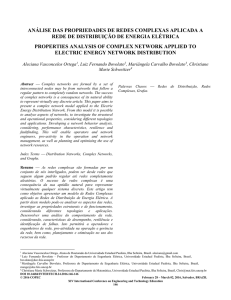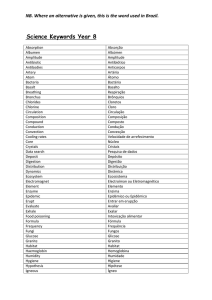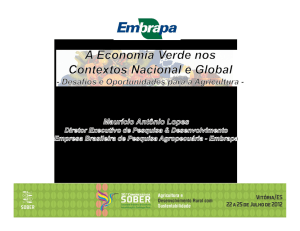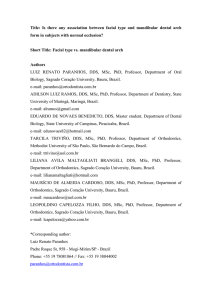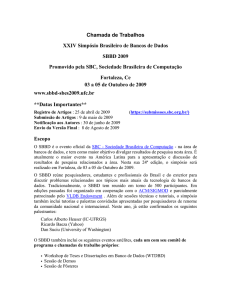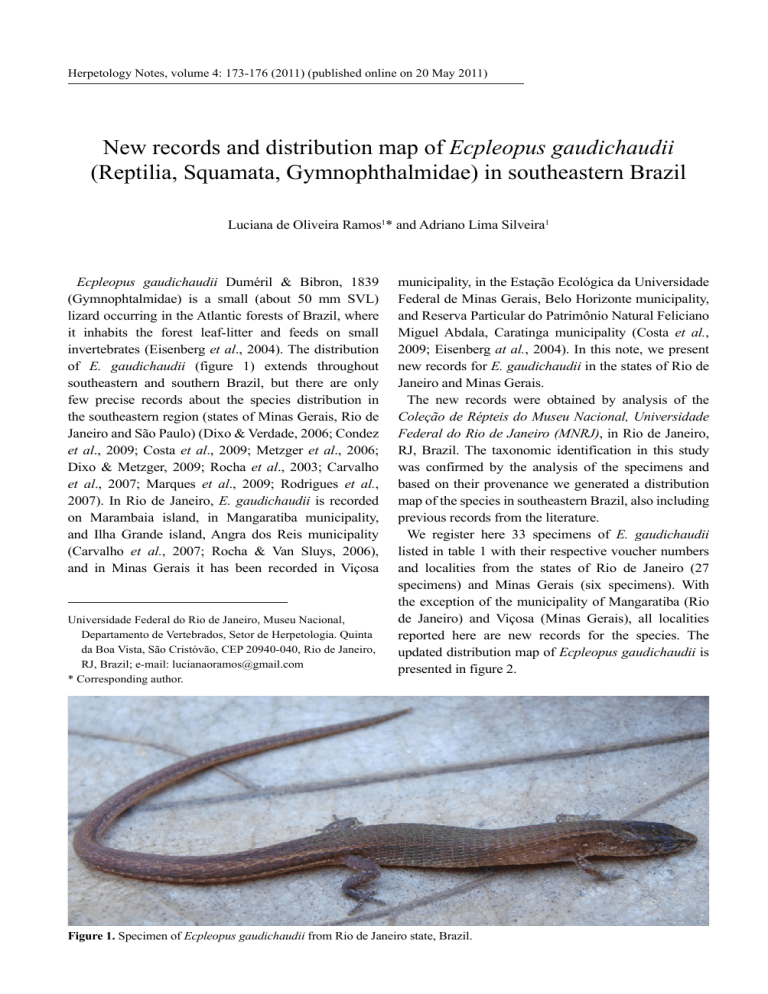
Herpetology Notes, volume 4: 173-176 (2011) (published online on 20 May 2011)
New records and distribution map of Ecpleopus gaudichaudii
(Reptilia, Squamata, Gymnophthalmidae) in southeastern Brazil
Luciana de Oliveira Ramos1* and Adriano Lima Silveira1
Ecpleopus gaudichaudii Duméril & Bibron, 1839
(Gymnophtalmidae) is a small (about 50 mm SVL)
lizard occurring in the Atlantic forests of Brazil, where
it inhabits the forest leaf-litter and feeds on small
invertebrates (Eisenberg et al., 2004). The distribution
of E. gaudichaudii (figure 1) extends throughout
southeastern and southern Brazil, but there are only
few precise records about the species distribution in
the southeastern region (states of Minas Gerais, Rio de
Janeiro and São Paulo) (Dixo & Verdade, 2006; Condez
et al., 2009; Costa et al., 2009; Metzger et al., 2006;
Dixo & Metzger, 2009; Rocha et al., 2003; Carvalho
et al., 2007; Marques et al., 2009; Rodrigues et al.,
2007). In Rio de Janeiro, E. gaudichaudii is recorded
on Marambaia island, in Mangaratiba municipality,
and Ilha Grande island, Angra dos Reis municipality
(Carvalho et al., 2007; Rocha & Van Sluys, 2006),
and in Minas Gerais it has been recorded in Viçosa
Universidade Federal do Rio de Janeiro, Museu Nacional,
Departamento de Vertebrados, Setor de Herpetologia. Quinta
da Boa Vista, São Cristóvão, CEP 20940-040, Rio de Janeiro,
RJ, Brazil; e-mail: [email protected]
* Corresponding author.
municipality, in the Estação Ecológica da Universidade
Federal de Minas Gerais, Belo Horizonte municipality,
and Reserva Particular do Patrimônio Natural Feliciano
Miguel Abdala, Caratinga municipality (Costa et al.,
2009; Eisenberg at al., 2004). In this note, we present
new records for E. gaudichaudii in the states of Rio de
Janeiro and Minas Gerais.
The new records were obtained by analysis of the
Coleção de Répteis do Museu Nacional, Universidade
Federal do Rio de Janeiro (MNRJ), in Rio de Janeiro,
RJ, Brazil. The taxonomic identification in this study
was confirmed by the analysis of the specimens and
based on their provenance we generated a distribution
map of the species in southeastern Brazil, also including
previous records from the literature.
We register here 33 specimens of E. gaudichaudii
listed in table 1 with their respective voucher numbers
and localities from the states of Rio de Janeiro (27
specimens) and Minas Gerais (six specimens). With
the exception of the municipality of Mangaratiba (Rio
de Janeiro) and Viçosa (Minas Gerais), all localities
reported here are new records for the species. The
updated distribution map of Ecpleopus gaudichaudii is
presented in figure 2.
Figure 1. Specimen of Ecpleopus gaudichaudii from Rio de Janeiro state, Brazil.
174
Luciana de Oliveira Ramos & Adriano Lima Silveira
Table 1. Localities of the analyzed specimens with respective coordinates and voucher numbers.
Museum ID
State
Municipality
Locality
Coordinates
MNRJ 16433
RJ
Campos dos Goytacazes
Lagoa de Cima
21°44’50”S, 41°30’33”W
MNRJ 16434
RJ
Campos dos Goytacazes
Lagoa de Cima
21°44’50”S, 41°30’33”W
MNRJ 16368
RJ
Itaperuna
Fazenda São Vicente
21°04’58”S, 42°01’20”W
MNRJ 18075
RJ
Cachoeiras de Macacu
Fazenda Santa Bárbara
22°27’49”S, 42°39’10”W
MNRJ 12352
RJ
Cachoeiras de Macacu
Reserva Ecológica de Guapiaçu
22°29’04”S, 42°40’14”W
MNRJ 12089
RJ
Guapimirim
Estação Ecológica do Paraíso
22º29’02”S, 42°56’46”W
MNRJ 12096
RJ
Guapimirim
Estação Ecológica do Paraíso
22º29’02”S, 42°56’46”W
MNRJ 14551
RJ
Casimiro de Abreu
Reserva Biológica União
22°27’23”S, 42°01’59”W
MNRJ 15429
RJ
Casimiro de Abreu
Reserva Biológica União
22°27’23”S, 42°01’59”W
MNRJ 15563
RJ
Casimiro de Abreu
Reserva Biológica União
22°27’23”S, 42°01’59”W
MNRJ 15564
RJ
Casimiro de Abreu
Reserva Biológica União
22°27’23”S, 42°01’59”W
MNRJ 17319
RJ
Santa Maria Madalena
Parque Estadual do Desengano
21°53’03”S, 41°55’03”W
MNRJ 15262
RJ
Mangaratiba
Reserva Rio das Pedras
22°59’29”S, 44°06’01”W
MNRJ 15263
RJ
Mangaratiba
Reserva Rio das Pedras
22°59’29”S, 44°06’01”W
MNRJ 4519
RJ
Mangaratiba
Itacuruçá
22°54’49”S, 43°54’33”W
MNRJ 9792
RJ
Angra
Ilha Grande
23°10’56”S, 44°12’50”W
MNRJ 14143
RJ
Niterói
Itaipu
22°56’59”S, 43°02’02”W
MNRJ 17339
RJ
Niterói
Itaipu
22°56’59”S, 43°02’02”W
MNRJ 3717
RJ
Rio de Janeiro
Floresta da Tijuca
22°57’37”S, 43°16’23”W
MNRJ 4520
RJ
Rio de Janeiro
Parque Henrique Lage
22°57’38”S, 43°12’47”W
MNRJ 2131
RJ
Rio de Janeiro
Jacarepaguá
22°54’47”S, 43°20’02”W
MNRJ 2129
RJ
Rio de Janeiro
Realengo
22°53’56”S, 43°25’42”W
MNRJ 2132
RJ
Rio de Janeiro
Recreio dos Bandeirantes
22°57’21”S, 43°23’50”W
MNRJ 2133
RJ
Rio de Janeiro
Recreio dos Bandeirantes
22°57’21”S, 43°23’50”W
MNRJ 4514
RJ
Nova Iguaçu
Rebio Tinguá
22°32’30”S, 43°22’17”W
MNRJ 16435
RJ
Nova Iguaçu
Rebio Tinguá
22°32’30”S, 43°22’17”W
MNRJ 2564
MG
Lavras
MNRJ 18738
MG
Catas Altas da Noruega
Fazenda Ouro Verde
20°40’39”S, 43°29’46”W
MNRJ 18739
MG
Catas Altas da Noruega
Fazenda Ouro Verde
20°40’39”S, 43°29’46”W
MNRJ 18740
MG
Catas Altas da Noruega
Fazenda Ouro Verde
20°40’39”S, 43°29’46”W
MNRJ 4517
MG
Juiz de Fora
21°45’51”S, 43°20’58”W
MNRJ 4516
MG
Viçosa
20°45’16”S, 42°52’57”W
21°14’44”S, 44°59’59”W
The localities in Rio de Janeiro and Minas Gerais states
cited above are characterized by dense rainforests and
semi-deciduous seasonal forests (phytophysiognomies
of the Atlantic Forest biome) (Instituto Brasileiro de
XXXX
175
Figure 2. Distribution for Ecpleopus gaudichaudii in southeastern Brazil – RJ: Rio de Janeiro, MG: Minas Gerais, SP: São Paulo.
Blue triangles represent previously reported localities; red circles represent the new records.
Geografia e Estatística, 2004).
With these new records, the known distribution of E.
gaudichaudii is expanded, especially in the state of Rio
de Janeiro, where it was previously recorded for two
localities only, and we conclude that its distribution
is widespread throughout the state. The species’
distribution in Minas Gerais state is also expanded.
Acknowledgment. We are grateful to Davor Vrcibradic for critical
revision of the manuscript and many helpful suggestions.
References
Carvalho, A.L.G., Araujo, A.F.B., Silva, H.R. (2007): Lagartos da
Marambaia, um remanescente insular de Restinga e Floresta
Atlântica no Estado do Rio de Janeiro, Brasil. Biota Neotrop.
7(2): 221-226.
Condez, T.H., Sawaya, R.J., Dixo, M. (2009): Herpetofauna dos
remanescentes de Mata Atlântica da região de Tapiraí e Pieda­
de, SP, sudeste do Brasil. Biota Neotrop. 9(1): 1-29.
Costa, H.C., Fernandes, V.D., Feio, R.N. (2009): Lizards and Amphisbaenians, municipality of Viçosa, state of Minas Gerais,
southeastern Brazil. Check List 5(3): 732-745.
Dixo, M., Verdade, V.K. (2006): Herpetofauna de serrapilheira da
Reserva Biológica de Morro Grande, Cotia (SP). Biota Neotrop.,
6(2): http://www.biotaneotropica.org.br/v6n2/pt/fullpaper?bn00
806022006+pt (last access in 20/04/2010).
Dixo, M., Metzger, J.P. (2009): Are corridors, fragment size and
forest structure important for the conservation of leaf-litter lizards in a fragmented landscape? Fauna & Flora Intern., Oryx,
43(3): 435–442.
Eisenberg, C.C., Cassimiro, J., Bertoluci, J. (2004): Notes on the
diet of the rare gymnophthalmid lizard Ecpleopus gaudichaudii
from southeastern Brazil. Herpetol. Rev. 35(4): 336-337.
Instituto Brasileiro de Geografia e Estatística. (2004). Mapa de
Vegetação do Brasil. 3. ed. Instituto Brasileiro de Geografia e
Estatística. 1 mapa. Escala 1:5.000.000.
Marques, O.A.V., Pereira, D.N., Barbo, F.E., Germano, V.J., Sawaya, R.J. (2009): Os Répteis do Município de São Paulo: diversidade e ecologia da fauna pretérita e atual. Biota Neotrop.,
9(2): 139-150.
Metzger, J.P., Alves, L.F., Pardini, R., Dixo, M., Nogueira, A.A.,
Negrão, M.F.F., Martensen, A.C., Catharino, E.L.M. (2006):
Características ecológicas e implicações para a conservação da
Reserva Florestal do Morro Grande. Biota Neotrop. 6(2): http://
www.biotaneotropica.org.br/v6n2/pt/fullpaper?bn01006022006
+pt (last access in 20/04/2010).
176
Luciana de Oliveira Ramos & Adriano Lima Silveira
Rocha, C.F.D., Bergallo, H.G., Pombal JR., J.P., Geise, L., Van
Sluys, M., Fernandes, R., Caramaschi, U. (2003): Fauna de anfíbios, répteis e mamíferos do Estado do Rio de Janeiro, Sudeste
do Brasil. Publ. Avul. Mus. Nac., Rio de Janeiro 104: 3-23.
Rocha, C.F.D., Van Sluys, M. (2006). New records of reptiles from
Ilha Grande island in Rio de Janeiro state, Brazil. Herpetol. Rev.
37(1): 112-114.
Rodrigues, M.T., Pellegrino, K.C.M., Dixo, M., Verdade, V.K.,
Pavan, D., Argôlo, A.J.S., Sites Jr., J.W. (2007). A new genus
of microteiid lizard from the Atlantic Forest of State of Bahia,
Brazil, with a new generic name for Colobosaura mentalis, and
discussion of relationships among the Heterodactylini (Squamata, Gymnophthalmidae). Am. Mus. Novit. 3565: 1-27.
Accepted by Zoltán T. Nagy; Managing Editor: Hamed Cheatsazan

